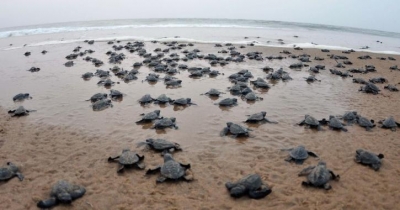
The coast of Odisha welcomes female olive ridleys in several thousands every year. It is said that the female returns to nest in the same place it was born in. Among the most important mass nesting sites in Odisha are the mouth of the Rushikulya river and the Devi river, and Gahirmatha Turtle Sanctuary. During arribada – mass nesting – female turtles arrive from the ocean to the beaches and lay an average of 100 eggs each, taking the final tally to a few lakh eggs. Though not as mass nesting sites, coastal regions of States such as Maharashtra, Goa, Tamil Nadu, Andhra Pradesh and Kerala too host olive ridley turtles for sporadic nesting,
An unusual phenomenon
The breeding season of the olive ridley turtle is between November and May, In Rushikulya, mass nesting normally happens between February and March. However, the year 2020 turned out to be slightly unusual for two reasons – one, the nesting began only in the third week of March (delayed due to torrential rains in the region), and two day- nesting was witnessed. Olive ridley turtles usually lay their eggs only at night. Officials say that the last time day nesting happened was in 2013. Since the period coincided with the national lockdown imposed due to COVID-19, one does wonder if the day-nesting occurred due to human absence. However, experts deny there’s any connection between the lockdown and the day nesting. In fact, it is said that mass nesting is influenced by factors such as tidal conditions, wind direction and lunar phase rather than human presence. That human absence did not in any way influence the turtles’ nesting behaviour becomes more credible by the fact that while the 2020 season saw the arrival of more than 3.00,000 olive ridleys, in 2019. the turtles completely skipped Rushikulya, and the year before that they actually nested twice (in February and April)! But what the lockdown did do was to help authorities allow more personnel to improve care for turtles rather than towards monitoring humans who visited the beaches.
Threats
Despite only one in a thousand reaching adulthood, the olive ridley turtle is the most abundant in the world. However, it has been listed “Vulnerable” by the International Union for Conservation of Nature, and its numbers are said to be declining. Accidental injury and death caused when trapped in fishing nets has been of great concern. Though Turtle Excluder Devices have helped control this to a certain extent such injuries and deaths continue. Though measures are in place to protect them, the turtles are killed for meat and their eggs are consumed. When unprotected, eggs and newborns are consumed by birds and stray animals on the beach. Among the greatest threats to the eggs is sea erosion. There have been instances of even a few lakh eggs being lost to high tide. Sea erosion destroys certain sandy stretches that the turtles use for mass nesting. When the stretches disappear, the turtles lay their eggs on sand bars formed by erosion. These sand bars – and along with them, the eggs – are washed away by high tide.
Olive ridley facts
- Olive ridley turtles get their name from the greenish colour of their skin and shell.
- They are the most abundant turtles in the world.
- They are found in warmer waters of the Southern Atlantic, Pacific and Indian Oceans.
- They weigh up to 50 kg and are about two feet long.
- These turtles feed mostly on jellyfish, shrimp, snails, crabs, and fish and their eggs. They occasionally eat algae and seaweed as well.
- However, only one hatchling in a thousand makes it to adulthood.
Picture Credit : Google
